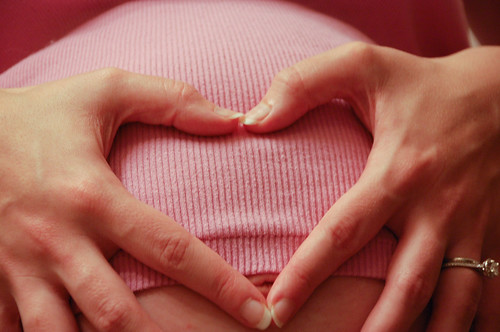My husband and I were cautiously excited when those two pink lines showed up. I had experienced a very early miscarriage a few months earlier and was afraid of the same thing happening again. As those first weeks ticked by though, everything was fine. I made it to almost seven weeks, and then the bleeding started. I was worried and sure I had lost another baby. The next day, my midwife referred my to the perinatal specialists who were able to see me within hours. As I lay on the table in the dark ultrasound room, the technician told me that I had a bicornuate uterus. A what? I had never heard of such a thing and. She didn’t say much else, but indicated this was rare and could explain the bleeding.
Staring at the fuzzy print out images of my baby, I waited to talk with the doctor and find out what this diagnosis was all about. As a woman in my mid twenties with no prior health problems, I had been planning and hoping for a low intervention birth with midwives in a birth center. But as I talked with the doctor, I discovered that would be unlikely. She drew a picture of a heart on the back of used printer paper and told me that was essentially what my uterus looked like. A bicornuate uterus is one of a series of Mullerian anomalies affecting the female reproductive anatomy. Basically, as a fetus when my uterus was developing, the last stage didn’t happen correctly. Instead of the typical upside down pear shape, I have a perfect heart shape.
 //embedr.flickr.com/assets/client-code.js
//embedr.flickr.com/assets/client-code.js
The doctor explained that some of the risks include miscarriage, preterm labor, intrauterine growth restriction, and most common, breech position. I went home and told my husband the news. And then, as any woman of the internet age would do, I turned to Dr. Google to find out more. A torrent of tragic stories about preterm labor, late miscarriage, and intrauterine growth restriction bombarded me. I found a horrifying statistic that only 60 percent of bicornuate uterus pregnancies ended in a live birth. 60 percent?! My already anxious mind went crazy imagining all the terrible things that could happen.
I joined an online support group of women who had the same or similar condition as me. Several of them had suffered tragic losses, harrowing NICU stays after preterm delivery, and struggles with repeat miscarriages. At the same time, many more seemed to have normal pregnancies and had delivered at or near full term. As I talked with various high risk doctors, they painted a less alarming picture than what I encountered online. Although they mentioned the possibility of preterm labor, they indicated that it was relatively rare even among BU patients and that the major potential complication, by far, was breech position.
At that point I should have quit consulting Google and listened to my doctors, but I just couldn’t stay away. I would even pull my phone out to look up random questions that popped into my mind on my long train commute. About half way through the pregnancy, we moved to a smaller town that lacked the resources of the Washington, DC practice I had been seeing. I was supposed to have biweekly cervical length checks between 16 and 22 weeks to monitor my risk for preterm labor but because of the move, I had to wait a month for my next one. I was a nervous wreck, sure that I had over exerted myself in the move. All the statistics and stories swirled around in my head as one August afternoon, I broke down crying at my desk, unable to focus on work for the rest of the day.
I was finally able to have the cervical length exam and found out that it was perfectly normal. I breathed a little sigh of relief and thanked God for bringing me that far. The pregnancy seemed to be dragging on, but I tried my best to take it one day at a time. As I progressed into the third trimester I relaxed some and started to prepare for the birth of our daughter. Despite my prayers, chiropractic work, and hanging upside down off the couch, the baby was breech in the end. She was born by cesarean section two days before her due date.
There was no guarantee that everything would turn out as well as it did for me. I am thankful that I did not experience any of the tragic complications associated with my condition, but I know I just as easily could have. Even so, the anxiety added from the Internet searches would have made no difference except to make things more difficult along the way.
The wealth of information available about pregnancy on the Internet is a blessing in the sense that it can provide women with information that is beneficial and, in some cases, able to inform us of warning signs to talk about with our doctors and midwives. But for an already anxious person like myself, with a rare, little studied condition, the knowledge of what could happen was just too much. In future pregnancies, I will try my best to stay away from Google searches and message boards and take things one day at a time.




Leave A Comment